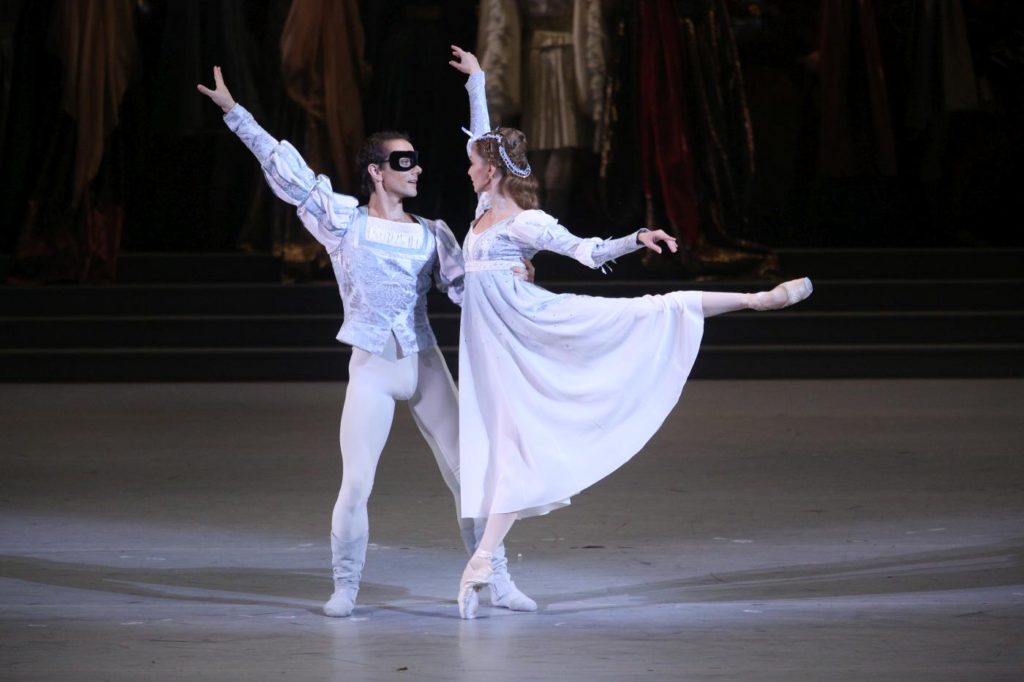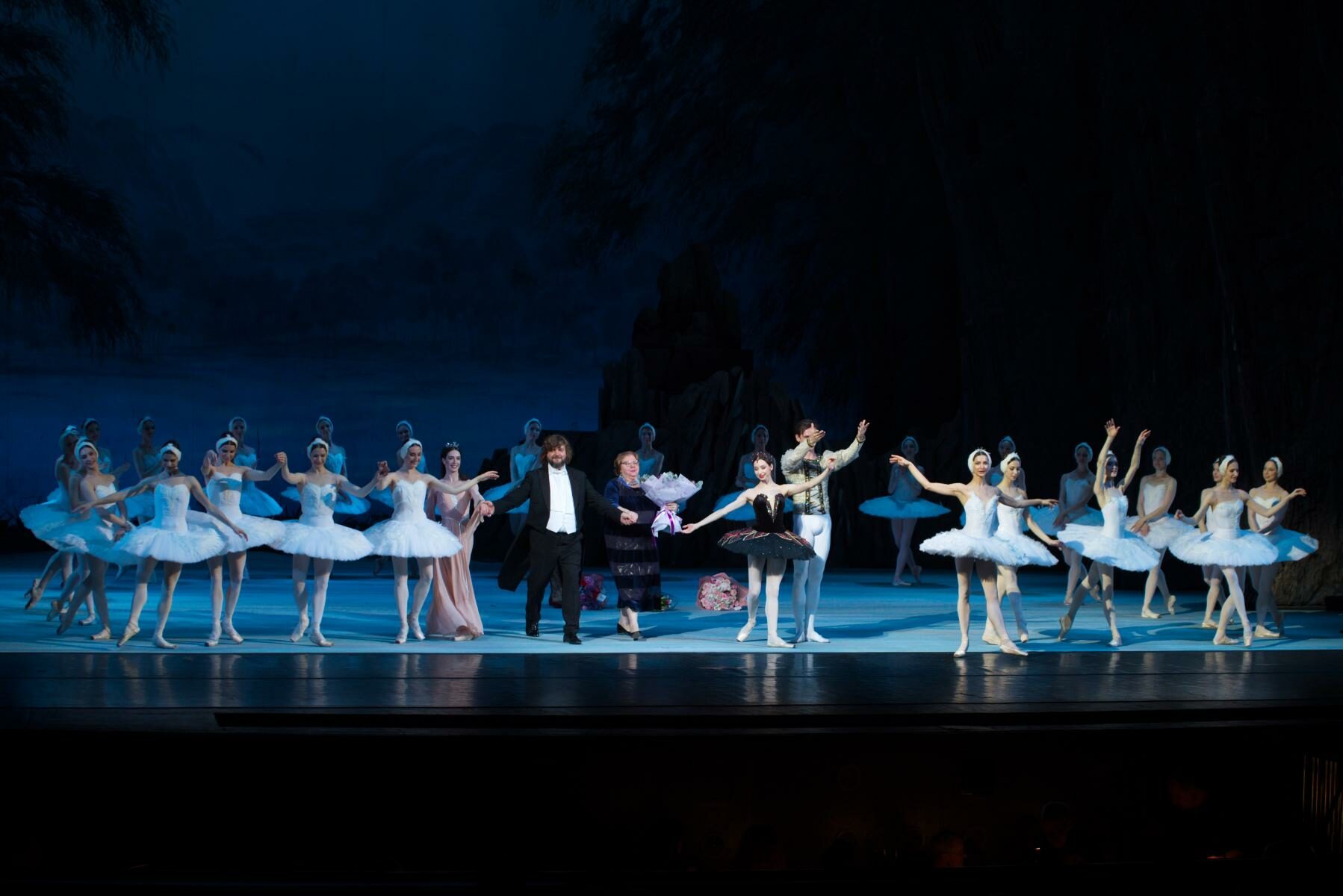“Romeo and Juliet”
Bolshoi Ballet
Bolshoi Theatre
Moscow, Russia
November 25, 2017
by Ilona Landgraf
Copyright © 2017 by Ilona Landgraf
 Last week the Bolshoi Ballet added a second version of “Romeo and Juliet” to its repertoire. By Alexei Ratmansky, it premiered at the National Ballet of Canada in 2011 and is being performed on the New Stage of the Bolshoi Theatre. As during recent years, Yuri Grigorovich’s adaption will be shown on the Bolshoi’s Historic Stage.
Last week the Bolshoi Ballet added a second version of “Romeo and Juliet” to its repertoire. By Alexei Ratmansky, it premiered at the National Ballet of Canada in 2011 and is being performed on the New Stage of the Bolshoi Theatre. As during recent years, Yuri Grigorovich’s adaption will be shown on the Bolshoi’s Historic Stage.
Ratmansky cast three leading couples: Ekaterina Krysanova & Vladislav Lantratov; Anastasia Stashkevich & Vyacheslav Lopatin; and Evgenia Obraztsova & Artemy Belyakov; however the pairings switched in the course of the first run. I saw the fourth performance after the premiere; Stashkevich was Juliet alongside Lopatin’s Romeo.
In an interview printed in the program booklet, Ratmansky said about the dramatic composition that he “never liked brooms for sweeping the town square, fruit and vegetables, and other overly realistic details.” So no paraphernalia familiar from other popular versions were used: no stringy chicken was snatched from a market stall; Friar Laurence didn’t ponder over a skull; Juliet had no bath in the zinc tub, and Lady Capulet broke the matter of the upcoming wedding to Juliet merely by miming (i.e.without presenting her with her first ball dress). Yet it turned out that by avoiding meant-to-be-realistic add-ons, the story’s credibility increased. Among the scarce props was a white flower dropped by Juliet and thrown back by Romeo; it tenderly initiated the balcony scene. Indispensable were Juliet’s letter to Romeo, the vial containing the potion, another one with the poison that killed Romeo, and the dagger Juliet used to stab herself. One prop was as widely present as enmity – swords. The men at the Capulets’ ball formally crossed blades when dancing (John Cranko had them carry cushions) and even Romeo picked up his sword from the floor next to the bed before leaving Juliet after their wedding night.
Richard Hudson’s costumes referenced the Early Renaissance fashion depicted in Pierro della Francesca’s paintings. Both Capulet and Montague folk wore similarly colorful garb rather than being distinguished by their outfits like two competing sport teams. Who opposed and fought against whom became apparent through action and the positioning of the groups. Lavish brocade and heavy velvet dominated the attire of the aristocrats, while Juliet looked like a delicate, pristine flower in her white and blue dress.
Hudson’s set elements were plain, visually effective, and allowed smooth scene changes. Unadorned auburn facades of palazzi surrounded the town square; huge, patterned curtains and a canopy bed gave Juliet’s chamber an atmosphere of warmth and privacy yet was also spacious. I hadn’t been aware how important it was that the church has an aisle down which the lovers pass to approach Friar Laurence for their wedding. Its presence emphasized the momentousness of the ceremony. The crypt was austerely gray and had a staircase in the background; having descended the staircase solemnly the Capulet and Montague families discovered the awful double death. The scene was so well balanced visually that it was worthy of capture in a painting.
Lighting designer Jennifer Tipton cleverly played with contrasts. For example, in the first scene Romeo was the only brightly lit figure upstage center, surrounded by a pitch-black town square. Did he bear light in himself or was he predestined to carry light into a society imbued by a dark feud? Or both? Later, during Mercutio and Romeo’s fight with Tybalt, the horizon turned threateningly yellow-orange, as if sulfur that would ignite.
In the program interview mentioned above, Ratmansky revealed that Nureyev’s production of “Romeo and Juliet” is his favorite. Just like Nureyev, Ratmansky expresses as much as possible through dance, but where Nureyev crammed in side stories and portrayed his protagonists’ psyche, Ratmansky pruned and distilled. He dropped the role of Rosaline, Romeo’s first love interest. The love between Romeo and Juliet was so exceptional it needed no comparison with a mundane flirtation. Nureyev’s version brimmed with eroticism and flirtations, Ratmansky’s didn’t. Juliet had no nightmares of her virginity being taken by death; she didn’t charge Romeo with having killed her cousin Tybalt; and she drank the potion courageously without suffering from hallucinations. Why Friar Laurence’s letter didn’t reach Romeo wasn’t shown and Benvolio didn’t bear the message of Juliet’s apparent death to Romeo. Nevertheless, one understood the goings-on. The fight between Count Paris and Romeo at the crypt and Romeo’s dance with Juliet’s lifeless body were eliminated as well. Instead, Ratmansky deviated from Shakespeare’s text and had Juliet wake up from her slumber prematurely. She witnessed Romeo’s dying and he noticed his fatal mistake. Could the drama be more terrible?
In some versions of “Romeo and Juliet” the final reconciliation of the two quarreling families is omitted, while in others the moment tends to look contrived. Ratmansky opted for including the scene. He used extremely reserved choreography – single, sparse and almost brusque movements and gestures. The effect was intense and made one choke. One hoped that the emotional rigidity of the families would melt and that the young lovers’ death hadn’t been for nothing.
Asked about the tradition of the Bolshoi Theatre in the interview, Ratmansky said, “It impresses, because all movements, all gestures are presented in an exaggerated way. […] I see in it the sign of aspiration for success, for direct contact with the audience, the desire to fascinate it emotionally […].” He took the other route. No exaggerations, no bravura stunts, only sincere dancing and acting.
So what was left given all the pruning and restraint? We saw two souls destined for each other. They met, immediately connected, and from that point forward everything between them was as easy as a spiritedly flowing mountain stream. Romeo and Juliet’s romance unfolded on its own. Generally, that’s the same in every production, but whereas other choreographers depict earthly love, Ratmansky shows the essence – universal love. It has often been debated whether Romeo and Juliet’s love affair had to be shattered because it resembled an ideal incompatible with reality. In Ratmansky’s depiction, one could imagine their love fulfilled, and certainly both would not have become as callous as their parents.
Stashkevich’s Juliet was a daughter every mother would be very glad to have. One marveled at the lightness and joie de vivre Juliet radiated. She seemed like a ray of spring sun playing with its reflections on the leaves and enjoying it immensely. Her family’s quarreling with the Montagues neither burdened nor tainted her. Juliet was much more attached to her good-hearted nurse (Anastasia Vinokur) than to her mother (Nino Asatiani). Her mother favored etiquette over feelings. Lord Capulet (Nikita Elikarov) even got violent to silence his daughter’s opposition against marrying Count Paris (Ivan Alexeyev). Paris was mannerly, neat (in his sand-colored tunic complete with a red belt and red ballet slippers he almost looked like a young woman) and certainly a good catch – but one for another girl.
I disagree with what Ratmansky said about his ballet – that the interpersonal relationships it depicted were modern – in relation to one role. One will hardly find a young man today as candid, open and firm as his Romeo. Lopatin convincingly portrayed the seriousness of Romeo’s love for Juliet. Though Romeo’s sidekicks teased him, being in love made him more self-assured and stronger, and consequently more mature than they were. Lopatin and Stashkevich’s stage chemistry was excellent, partnering without any physical effort.
It was difficult at first to discern which of Romeo’s two buddies was Mercutio (Artur Mkrtchyan) and which Benvolio (Georgy Gusev). Both danced a great deal, wore daring patterns, and couldn’t stop teasing Juliet’s nurse like boys who never grew up. I laughed at the way the three friends tiptoed onstage before slipping into the Capulets’ house to join the ball. It’s the entry Cranko choreographed and a priceless characterization of the young men. That Mercutio died without playing the clown was a point for credibility. After his death the air on the town square was colder.
Tybalt (Alexander Vodopetov) needed to boast to feel important. He played around with his sword like today’s men with the keys of a show-off car. Defense of his and his family’s reputations and dignity drove his behavior.
Two crucial moments in the piece were connected to Yuri Ostrovsky as Friar Laurence. Maybe it was due to Ratmansky’s writing, or the cast, or the stage, or Ostrovsky, or all factors together, that a shower of energy came down from above the moment Friar Laurence blessed Romeo and Juliet’s marriage. The same happened in the very last scene in the crypt, when the monk bowed his head before the Duke of Verona (Alexey Loparevich) admitting his involvement and being forgiven in the same moment.
Dancers in supporting roles were Vera Borisenkova (Lady Montague) and Alexander Fadeechev (Lord Montague); Anna Balukova and Ksenia Sorokina portrayed the two prostitutes. Iliya Vladimirov, Mikhail Kemenov, Alexey Putintsev and Maxim Surov larked about as the fools.
The corps performed with brio and seemed to relish the folk dance elements including vigorous stomping. Once they turned in a line towards the audience, their feet pounding the floor, an example of the “direct contact with the audience,” Ratmansky had talked about.
From love’s sweetest bliss to imminent threat and deep grief – Prokofiev’s score contains everything. I do not know what Pavel Klinichev did with the Bolshoi Orchestra in the pit, but their rendition was so extraordinary clean, subtle and powerful, that it swept one away.
| Links: | Website of the Bolshoi Theatre | |
| Excerpts of the premiere (video) | ||
| Documentary about the production (in Russian) | ||
| Photo: | 1. | Vyacheslav Lopatin (Romeo) and Anastasia Stashkevich (Juliet), “Romeo and Juliet” by Alexei Ratmansky, Bolshoi Ballet 2017 © Bolshoi Ballet / Elena Fetisova |
| Editing: | Julie Bradley |



